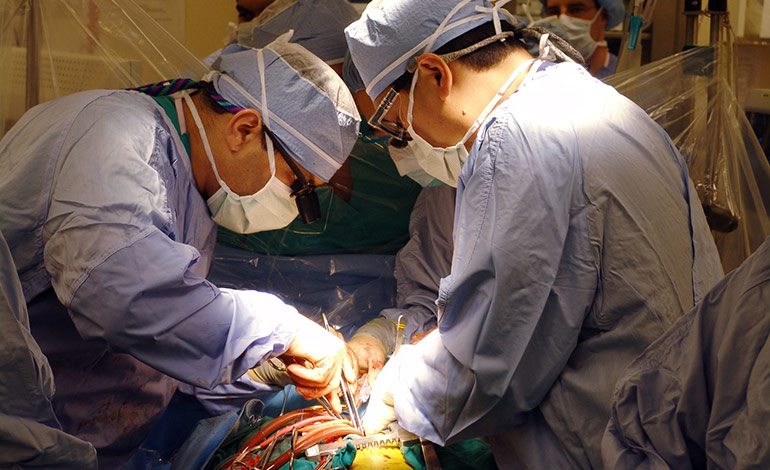Heart Surgery
Coronary Artery Bypass Graft (CABG)
Each year, 300 CABG procedures are performed at Memorial Hermann-TMC, treating such disorders as unstable angina, acute coronary syndrome, non-ST segment elevation and myocardial infarction. Our surgeons utilize the least invasive techniques possible, to achieve less blood loss, reduced pain, and achieve a shorter length of stay and faster recovery.
Off-Pump Coronary Artery Bypass (OPCAB)
The off-pump procedure provides a safer alternative to the heart-lung machine. Surgeons attach the bypass graft to the blocked artery while the heart is beating. This is accomplished using state of the art devices to stabilize the heart.
MIDCAB (Minimally Invasive)
The MIDCAB treats blockages in the left anterior descending artery (LAD) as well as its branches. (Right-sided blockage may be treated with a hybrid MIDCAB.) The surgeon makes a small incision between the ribs on the patient’s left side. Heart-lung equipment may or may not be used.
Robotic Assisted Coronary Artery Bypass (RACAB)
The most recent technological advance, RACAB provides access to the coronary arteries without opening the sternum. The surgeon does not have direct contact with the patient but guides robotic instrumentation via a video monitor.
Hybrid Coronary Artery Bypass
Complex coronary blockages can be treated using a combination of the least invasive methods for revascularization (reestablishing blood flow to the heart). This can be performed in partnership with invasive cardiology whereby a single vessel coronary artery bypass can be performed using minimally invasive approaches with percutaneous approaches to other coronary blockages in the hybrid operating room.
Valvular Heart Surgery
Valvular heart disease remains an integral part of the division’s clinical practice. With an increasingly older population, interventions on the cardiac valves will inevitably increase.
We are developing and performing the latest techniques in aortic valve repair. If replacement is required, then a full armamentarium is at our disposal including mechanical, bioprosthetic (stented and stentless), allograft (“Homograft”), and the Ross procedure. Minimally invasive approaches to the aortic valve are also offered.
Because the benefits of mitral valve repair have been established, the latest repair techniques are used. In addition, minimally invasive approaches including robotic mitral valve repair are performed.
Research on new technologies or the treatment of heart diseases including percutaneous heart valve replacement are performed.
Minimally Invasive Mitral Valve Repair
The surgeon inserts a scope through a tiny incision, views the operative area on a video monitor, and repairs the valve. Advantages include reduced stroke risk, less chance of infection, avoidance of anticoagulants and a longer-lasting valve. In addition, our surgeons have access to the Hybrid Operating Room allowing performance of percutaneous valve replacement and repairs.
Surgical Treatment of Atrial Fibrillation
Atrial fibrillation (Afib) is the most common irregular heart rhythm in the United States, affecting about 2.5 million people. More than 160,000 new cases of atrial fibrillation are diagnosed each year. The goals of treatment for atrial fibrillation include a return to normal heart rhythm, control of heart rate, and prevention of blood clots and strokes.
Using the very latest technology, we can now extend treatment to virtually all patients with Afib. Patients considered for surgical ablation fall into two groups: (1) Patients with isolated atrial fibrillation, who may be candidates for keyhole or minimally invasive treatment approaches (Robotic or thorascopic) or the Maze procedure or (2) Patients with atrial fibrillation who require heart surgery for other reasons, most commonly coronary artery disease or valvular heart disease. Surgeons may perform either a classic Maze procedure or a modified Maze procedure.
Surgical treatment of Heart Failure
Surgery is aimed at stopping further damage to the heart and improving the heart’s function. Surgical procedures include: High risk conventional surgeries (coronary artery bypass surgery and valve surgery combined with transmyocardial revascularization (TMR)), surgery of the ventricle (LV restoration surgery (LVR)), implantable left ventricular assist devices (LVAD), and heart transplant.
